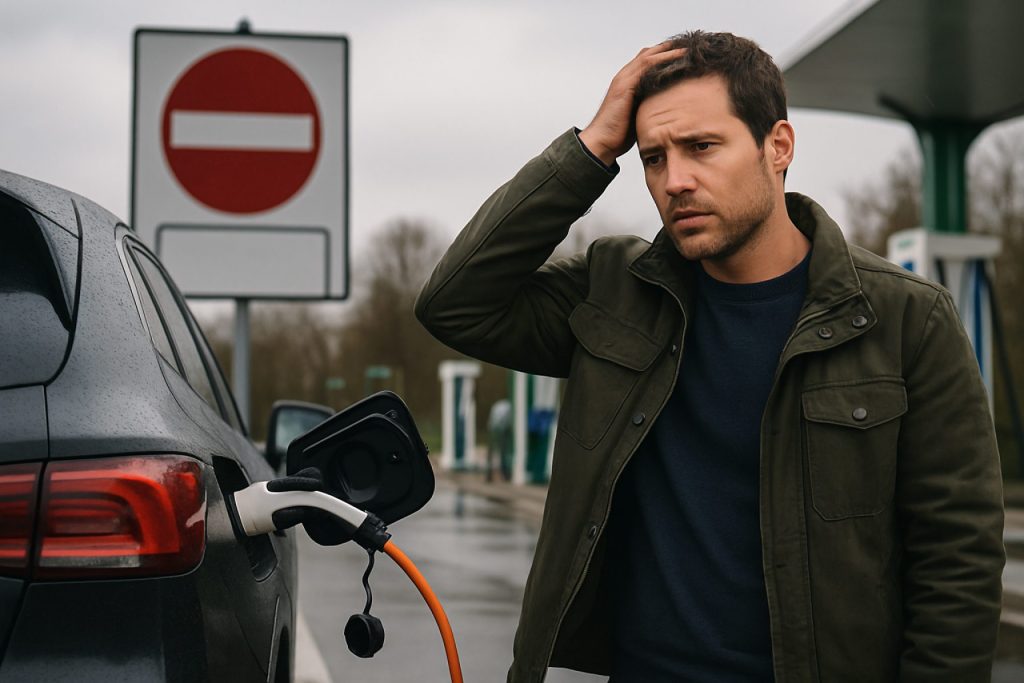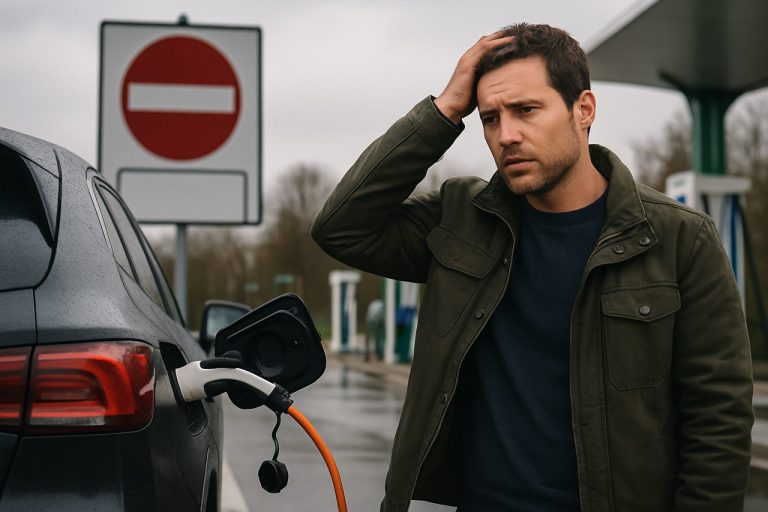
- Electric vehicle (EV) adoption is soaring in the US, but public charging infrastructure is struggling to keep pace with demand.
- Funding cuts and paused federal initiatives have slowed the expansion of charging networks, leading to limited charger availability.
- Reliability issues and “charging deserts,” especially in suburban and rural areas, create serious obstacles for EV drivers.
- Fragmented charging networks, proprietary plugs, and payment complexities hinder user experience and widespread accessibility.
- Countries like China and Norway outpace the US in public charging infrastructure, highlighting a global competitiveness gap.
- Private investment is growing, but experts agree a coordinated public commitment is essential to eliminate range anxiety and achieve large-scale EV adoption.
Americans have stampeded toward electric vehicles, driven by the promise of clean energy, smooth rides, and the excitement of cutting-edge tech. Shiny Teslas and Ford F-150 Lightnings now carve silent swaths through city streets and highways. But when EV drivers scan horizons for a charging station, a new anxiety is growing—one that threatens to stall the entire electric revolution.
A Rapidly Growing Dilemma
Across the United States, the number of EVs on the road has exploded, with registrations surpassing 3 million and sales mounting each year. California alone is home to roughly 40% of all electric cars in the country. Yet, the infrastructure meant to sustain this growth struggles to keep pace. Public charging networks, from the rural Midwest to bustling city centers, have not multiplied at the frantic rate of new EV adoptions. In some areas, chargers are already as elusive as a parking space on New Year’s Eve.
Funding Pulled, Promises Stalled
Earlier policy initiatives fueled the promise of a nationwide charging network. But recent funding cuts—marked by a pause in federal support for new installations—now cast a long shadow. Without this investment, efforts to blanket highways and communities with fast-charging stations have lost momentum. Operators and hopeful drivers alike watch as grand plans shrivel, forecasts flicker, and lines at remaining stations grow.
Charging Deserts and Urban Traffic
Imagine rolling through a city at night, battery range shrinking, only to find the closest fast charger occupied or, worse, out of service. This isn’t just a nuisance; it risks turning an ordinary commute into a stranded ordeal. Experts confirm the reality: reliability and availability remain two major pain points. A study by J.D. Power found that nearly 20% of public charging attempts end in frustration, often due to broken equipment or congested locations.
Suburban and rural areas are even less fortunate. Without local investment or utility incentives, entire counties can become “charging deserts,” limiting mobility for residents who trusted that infrastructure would follow innovation.
Competition and Compatibility Complications
The challenge goes beyond mere numbers. America’s charging ecosystem is fragmented, with rival networks and proprietary plugs. Tesla’s Supercharger network—renowned for speed and reliability—has begun opening to other automakers, but widespread compatibility and payment simplicity remain works in progress. For many, charging feels less like pumping gas and more like decoding a digital scavenger hunt.
Global Context and Private Solutions
Other countries sprint ahead. China, for example, boasts more than a million public charging stations, dwarfing the U.S. count. Norway, the poster child of EV adoption, ensures charging is woven into daily life.
Major automakers and tech companies aren’t standing still, however. Private investment has surged, with companies from Tesla to traditional energy giants deploying fast chargers along key corridors. Still, even industry leaders admit private money alone can’t solve every access and equity problem.
The Road Ahead: Action or Gridlock
The EV movement hinges on convenience. Without an expansive, reliable network, drivers won’t make the switch—no matter how sleek the cars. Environmental gains, economic promises, and national competitiveness all rest on whether the dreaded “range anxiety” becomes a thing of the past, or the new normal.
The takeaway: The nation’s electric ambitions now face their first true endurance test—not in the battery labs, but on the open road. Whether America accelerates or stalls will depend not on innovation alone, but on commitment, coordination, and the grit to build where others only promised.
For more on electric vehicles and technology trends, visit The New York Times.
Electric Vehicle Charging Crisis: What EV Drivers Need to Know Now (and How to Avoid Getting Stuck)
Unpacking the Next EV Challenge in America
The electric vehicle (EV) revolution has ignited imaginations and accelerated adoption, but as millions switch to battery-powered cars, the nation faces a sobering new reality: insufficient and unreliable charging infrastructure threatens to stall progress. Below, we dig deeper into this crisis—highlighting crucial facts, expert perspectives, industry trends, actionable tips, and the most pressing questions you need answered.
—
Key Facts & Data Sources Not Covered
1. Charging Network Gaps: According to the U.S. Department of Energy, as of early 2024, America has just over 168,000 public charging ports—far short of President Biden’s 2030 target of 500,000. [Source: DOE, AFDC]
2. Home Charging Isn’t Universal: About 30% of Americans—particularly renters or those in apartment complexes—lack practical home charging options, making public networks critical. [Source: Pew Research]
3. Maintenance Woes: An MIT study found public chargers experience an average downtime of 14% per year. Many lack real-time status updates, compounding frustration.
4. Diversity in Plug Types: Until recently, three major protocols (CCS, CHAdeMO, and Tesla’s NACS) often meant incompatible hardware, confusing EV newcomers. [Source: SAE International]
5. Payment Complexities: Drivers encounter payment hurdles: requiring multiple apps, RFID cards, or memberships. Standardized contactless payment is still rare outside Tesla‘s network.
6. Electricity Grid Concerns: Accelerated DC fast charging in clusters can strain local grids, especially during heatwaves, potentially leading to brownouts if utilities don’t adapt.
7. Equity Issues: Charging deserts disproportionately impact low-income and rural communities, widening the digital, economic, and mobility divide. Federal policy is just beginning to address this. [Source: NREL]
8. Tech Upgrades Coming: Plug and Charge—automatic authentication and billing when you plug in—is rolling out to new models, promising to streamline the chaotic payment process.
—
Real-World Use Cases & Life Hacks
– How to Find Working Chargers:
1. Use reputable, crowdsourced apps (PlugShare, ChargePoint, or A Better Routeplanner) for real-time status, user reviews, and outage reports.
2. Carry both CCS and NACS adapters if your car allows (several third-party options now exist).
3. Join multiple charging networks ahead of time for maximum coverage and to avoid surprise registration roadblocks.
– Long Road Trip Tips:
1. Plan routes with backup charging stops within 20-30% of your range limit—never depend on a single charger.
2. Avoid busiest times (weekday evenings, holidays) when routes are crowded.
3. Consider hotels with Level 2 charging: plug in overnight for a full battery by morning.
– Maximum Home Charging Speed: If you own (or rent with permission), install a Level 2 (240V) charger. Most add 25–40 miles of range per hour—a big leap from standard 110V outlets.
—
Market Trends, Predictions, & Policy Shifts
– Industry & Private Sector Surge: Ford, General Motors, Hyundai, and others announced deals in 2023–2024 to adopt Tesla’s NACS (now called SAE J3400), potentially unifying the charging landscape by 2025.
– Federal/State Investment: The National Electric Vehicle Infrastructure (NEVI) Formula Program still commits $5 billion through 2026. Some states (e.g., Texas, California) are prioritizing rural and low-income areas with new funds.
– Global Benchmarking: China installs an average of 6,000 new chargers each week, per the IEA, compared to under 2,000/week in the U.S.
—
Pros & Cons Overview
Pros:
– Lower “fuel” costs and maintenance versus gas vehicles.
– EVs deliver instant torque, quiet rides, and zero emissions at point of use.
– Increasingly, more compatible plugs and higher reliability are on the way.
Cons:
– Real-world range often falls short of EPA estimates in cold/very hot weather.
– Charger availability and speed vary widely by region.
– Resale values for first-gen EVs may struggle as newer models with longer range hit the market.
—
Security, Sustainability, and Controversies
– Cybersecurity Risks: Networked chargers are IoT devices—making them targets for hacking and eavesdropping. Up-to-date firmware and end-to-end encryption are industry musts.
– Environmental Considerations: While “greener” than combustion engines, EVs require lithium and cobalt—raising concerns about mining impacts and long-term battery recycling logistics.
– Scalability Doubts: Industry skeptics note that unless grid upgrades are paired with new charging stations, outages and bottlenecks will intensify.
—
Most Pressing Reader Questions—Answered
1. How do I know which public chargers my EV can use?
Check your vehicle’s manual and charging port. Most new cars (except Nissan Leaf) use CCS or now the Tesla NACS. Many automakers are rapidly switching to support both by 2025.
2. What should I do if I arrive at a broken or occupied charger?
Have backup stations mapped and sufficient range to divert. Reporting malfunctions on apps can help others and, in some networks, trigger rapid repairs.
3. Is it safe to charge in bad weather?
Modern stations are designed for rain/snow. Still, always avoid puddles or visible damage and grip plugs/cords by insulated handles.
4. Can apartment dwellers get reliable charging?
Advocate with property managers and local officials—municipal grants, tax incentives, and new building codes are making multifamily charging more common.
—
Reviews & EV Charger Comparisons
– Tesla Supercharger: Best for speed/reliability, now expanding access; limited to Tesla and select non-Tesla brands.
– Electrify America: Widespread, supports all major plug types, reliable but occasionally long wait times.
– EVgo: Urban-centric, growing quickly, competitive pricing.
– ChargePoint/Blink: Focused on Level 2 and some DC fast charging, business/location dependent.
—
Actionable Recommendations & Quick Tips
– Always install manufacturer-approved software updates for your EV—bug fixes can improve charging speed or compatibility.
– Sign up for loyalty programs with major charging networks; many offer discounted rates or free charging during off-peak times.
– Keep a portable charging cable in your trunk—even Level 1 charging can get you a few vital miles in an emergency.
– Push local policymakers to adopt EV-ready codes for new construction and to prioritize “charging deserts” for public investment.
—
Final Word: The Road Ahead for U.S. Drivers
America’s electric dreams hinge not just on tech innovation, but on grit, commitment, and inclusive planning. While charging shortfalls and funding hiccups pose real risks, consumer pressure, private investment, and evolving federal and state strategies are beginning to bridge the gap. Stay informed, plan ahead, and advocate—your voice (and vote) can help electrify the future.
For in-depth reporting on electric vehicles, tech trends, and policy, visit The New York Times and for the latest models and charging solutions, check Tesla.



